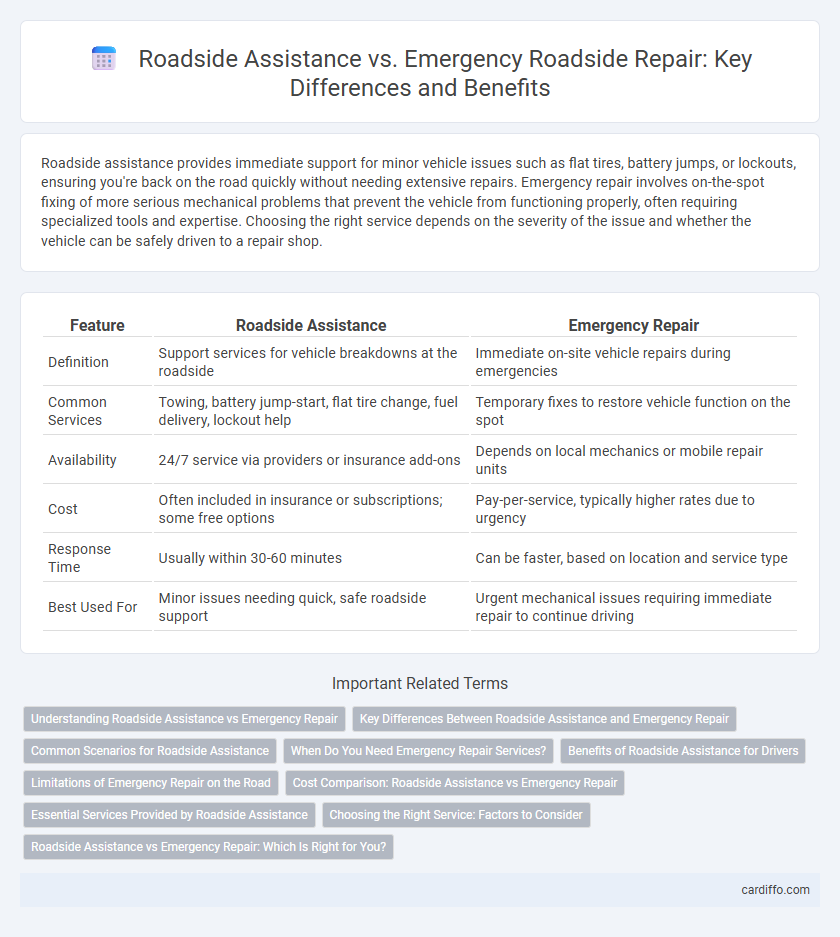Roadside assistance provides immediate support for minor vehicle issues such as flat tires, battery jumps, or lockouts, ensuring you're back on the road quickly without needing extensive repairs. Emergency repair involves on-the-spot fixing of more serious mechanical problems that prevent the vehicle from functioning properly, often requiring specialized tools and expertise. Choosing the right service depends on the severity of the issue and whether the vehicle can be safely driven to a repair shop.
Table of Comparison
| Feature | Roadside Assistance | Emergency Repair |
|---|---|---|
| Definition | Support services for vehicle breakdowns at the roadside | Immediate on-site vehicle repairs during emergencies |
| Common Services | Towing, battery jump-start, flat tire change, fuel delivery, lockout help | Temporary fixes to restore vehicle function on the spot |
| Availability | 24/7 service via providers or insurance add-ons | Depends on local mechanics or mobile repair units |
| Cost | Often included in insurance or subscriptions; some free options | Pay-per-service, typically higher rates due to urgency |
| Response Time | Usually within 30-60 minutes | Can be faster, based on location and service type |
| Best Used For | Minor issues needing quick, safe roadside support | Urgent mechanical issues requiring immediate repair to continue driving |
Understanding Roadside Assistance vs Emergency Repair
Roadside assistance provides timely help for minor vehicle issues such as flat tires, dead batteries, or lockouts, often included in insurance or auto club memberships. Emergency repair involves on-the-spot fixing of more serious mechanical problems that prevent safe vehicle operation, requiring specialized tools and expertise. Understanding the distinction helps drivers choose appropriate services and reduce downtime during unexpected breakdowns.
Key Differences Between Roadside Assistance and Emergency Repair
Roadside assistance primarily offers temporary solutions such as jump-starts, tire changes, and fuel delivery to help drivers get back on the road quickly, while emergency repair involves comprehensive diagnostics and fixing of vehicle issues on-site or in a workshop. Roadside assistance is generally subscription-based and designed for minor, immediate problems, whereas emergency repair requires skilled technicians performing in-depth repairs during accidents or severe breakdowns. The key difference lies in the scope and depth of service, with roadside assistance focused on quick fixes and emergency repair targeting long-term vehicle restoration.
Common Scenarios for Roadside Assistance
Roadside assistance commonly addresses scenarios such as flat tires, dead batteries, lockouts, and fuel delivery, providing quick help to drivers stranded on the road. Emergency repair usually involves more complex mechanical fixes that require a tow to a repair shop. Understanding these distinctions helps drivers select the right service for breakdowns, enhancing safety and minimizing downtime.
When Do You Need Emergency Repair Services?
Emergency repair services become essential when vehicle breakdowns involve critical issues such as engine failure, brake malfunctions, or transmission problems that pose immediate safety risks. Unlike general roadside assistance that handles basic tasks like tire changes or battery jumps, emergency repairs require specialized tools and expertise to diagnose and fix complex mechanical faults on-site. Prompt emergency repair services minimize downtime and prevent further damage, ensuring driver safety and vehicle reliability during unexpected breakdowns.
Benefits of Roadside Assistance for Drivers
Roadside assistance provides drivers with rapid support for unexpected vehicle issues, such as flat tires, dead batteries, or lockouts, ensuring minimal disruption and enhanced safety on the road. Unlike emergency repairs, roadside assistance often includes services like towing, fuel delivery, and on-the-spot minor repairs, reducing the need for costly garage visits. This convenience helps drivers save time, avoid stress, and maintain continuous mobility during emergencies.
Limitations of Emergency Repair on the Road
Emergency repair on the road often faces significant limitations, including restricted access to specialized tools and parts necessary for complex vehicle issues. Unlike roadside assistance, which provides immediate support like towing, battery jump-starts, and tire changes, emergency repairs may only temporarily fix problems until professional service is available. Environmental factors such as poor lighting, weather conditions, and traffic hazards further constrain the effectiveness and safety of emergency repairs conducted roadside.
Cost Comparison: Roadside Assistance vs Emergency Repair
Roadside assistance typically offers a cost-effective solution with fixed or subscription-based fees that cover common services like towing and tire changes, reducing unexpected expenses. Emergency repairs often involve higher, variable costs due to on-the-spot labor, parts replacement, and urgent service premiums. Comparing expenses reveals that roadside assistance plans provide budget-friendly access to essential help, while emergency repairs can lead to significantly greater out-of-pocket charges.
Essential Services Provided by Roadside Assistance
Roadside assistance offers essential services such as towing, battery jump-starts, tire changes, fuel delivery, and lockout assistance, ensuring prompt help for minor vehicle issues. Unlike emergency repair, which involves extensive on-site mechanical fixes or transport to a repair shop, roadside assistance focuses on quick, temporary solutions to get drivers back on the road safely. These services reduce downtime and provide peace of mind during unexpected vehicle breakdowns.
Choosing the Right Service: Factors to Consider
Choosing the right roadside help involves evaluating the urgency of the situation and the type of service required, with roadside assistance ideal for minor issues like tire changes or battery boosts, while emergency repair addresses serious breakdowns demanding immediate, on-site fixes. Consider response time, service coverage, and cost to ensure optimal support during vehicle troubles. Prioritizing professional expertise and availability can prevent prolonged delays and further damage.
Roadside Assistance vs Emergency Repair: Which Is Right for You?
Roadside assistance provides quick, on-the-spot help with common issues like flat tires, dead batteries, and lockouts, ensuring minimal disruption during your travels. Emergency repair involves more complex diagnostics and fixes that usually require towing your vehicle to a service center for professional treatment. Choosing between roadside assistance and emergency repair depends on the severity of the vehicle problem and the immediacy of the required solution.
Roadside assistance vs emergency repair Infographic

 cardiffo.com
cardiffo.com